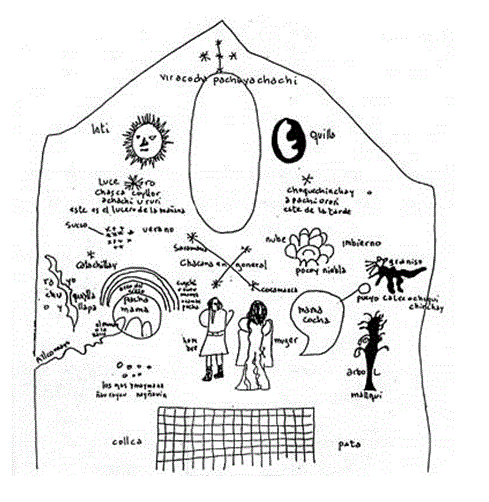|
TRANSLATE THIS ARTICLE
Integral World: Exploring Theories of Everything
An independent forum for a critical discussion of the integral philosophy of Ken Wilber
 Giorgio Piacenza is a sociologist student in the Certificate program leading to a Master's degree in Integral Theory at JFK University. Giorgio Piacenza is a sociologist student in the Certificate program leading to a Master's degree in Integral Theory at JFK University.SEE MORE ESSAYS WRITTEN BY GIORGIO PIACENZA Interdimensional ContactsAn Integral Search for Complementary
|
| The left pole "Yanan" can mean "essence," "substance," the "flower of flour," "pure," "clear," "pretending lover." |
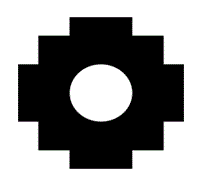 (This complementary relation of lovers together/ideal Yanantin) |
The right pole "Yana" can mean "dark," "enamored," "dependent," "negative," "in service of" and "pretended lover." |
The “chakana” or “Andean cross” figure represents a “bridge” between worlds. The three steps on each of the four sides represent the three main worlds of Inca Quechua Cosmology: “Hanan” or Upper world of abstract pre-given (past) principles and the higher deities; “Uku” (related to “Urin”) the lower world of what is the future world to emerge and, in the middle, “Kay,” the present world of experience. While everything that manifests depends on complementary dualities the central hole (“Chaupi”) represents “Kawsay” the source of living energy or Life. We might say that the “present experience” able to combine in a “tensional encounter” (or “Tinkuy”) both “Hanan” and “Uku” pachas in order to generate “Kay Pacha” is akin to what could be understood as the role of consciousness in Vedanta, in Integral Theory and in interpretations of quantum physics in which consciousness actualizes reality. The whole pattern can also be represented under numerous fractals and we might be able to combine the chakana with a torus in which the central hole is infinitely small and connected to the rest of the figure.
The Quechua or “Inca” “quadrants” refer to the relation between mirror-like complementary opposites and to a form of “both-and” logic. Before these “quadrants” (perhaps better described in the Inca Quechua language as “canchas” or enclosed spaces with expression characteristics) we have vertical and horizontal complementary relations: Up and Down (“Hanan” and “Urin”) and Left and Right (“Yanan” and “Yana”). These combine to form the ??quadrants,” “canchas” or enclosed (defined) experiential spaces which then relate diagonally.
“Yanan” refers to flower of flour, purity, clear and essence and “Yana” to enamored, in service, dependent.
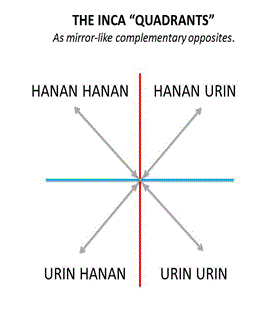
The “Inca Quadrants” have symbolic elements inside and their mirror-like complementary relation relates them diagonally. They are also considered to be propitious and less propitious with degrees of being positive or negative in some shamanic rituals. These elements may or may not correspond to what rises in Integral Theory's “quadrants” or they may or may not relate with the insides of these “quadrants.” This will have to be elucidated in future research.
The “canchas” or “Inca quadrant” symmetry is diagonal and may represent Subtle Realm connections offering some clues on how to increase the connection between the Subtle and Physical realms. Empirically acquired knowledge on this may have been lost or is kept for very few and rare initiates. Increasing the connection between the realms would entail sustaining a higher and stable degree of mutual cancelation between causal and retrocausal influences. Since “Hanan” is considered to be in the “past” and “Urin” in the “future” and their intersection (or, rather, “tensional encounter” or “Tinkuy”) in our present experience (in “Kay Pacha”) manifests the physical world of well-defined but correlated, “either-or” quadrants, tentatively speaking there might some general clues in this diagram.
between the Inca Quechua “Canchas”
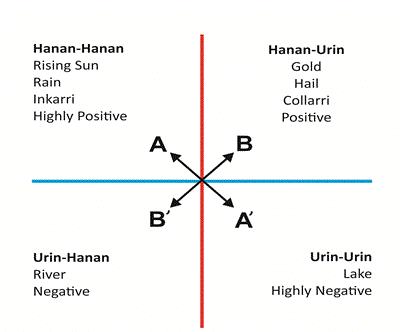
The pre-quadratic “dimensions” of Integral Theory also have a “both-and,” mirror-like complementary relation that belongs to a Subtle Realm nature and might function to connect the insides of the “quadrants.”
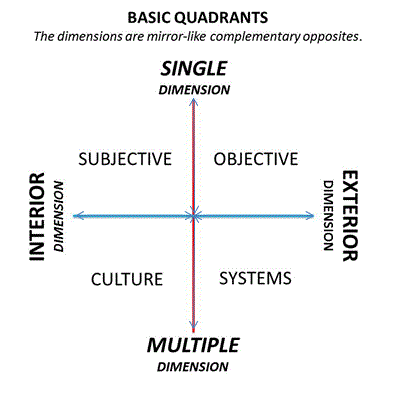
Thus the “Single,” “Multiple,” “Interior” and “Exterior” “dimensions” which when combining give rise to Integral Theory's (Subjective, Objective, Culture, Systems) “Quadrants” are mutually complementary under a Subtle Realm “both-and” logic. They are a step prior and have a complementary, mirror-like relation. However, their derivatives, the Subjective, Objective, Culture and Systems “quadrants” are separately defined and non-reducible to each other. These “quadrants” arise simultaneously and correspond more to a Physical Realm structuring expression under an “either-or” logic. However, on a deeper/higher level of connection with the Subtle Realm they may be coordinated through a connection with the more inclusive “both-and” logic (that can include and transcend the “either-or” logic). The intensity of what arises under each quadratic expression or 'perspective' may be coordinated through the insides which can exist in the Physical Realm and also operate with a “both-and” complementary, mirror-like relational logic.
This diagram shows the next level of distinction in quadratic expresssions or perspectives. However the insides of quadrants escape the limits imposed by either-or distinctiveness normally associated with distinct, not mutually reducible but simulataneously appearing “quadrants.” The “insides” belong to another and higher level of sensibility linking the outside of the quadrants with a higher or more inclusive ontological level of greater sensibility and operational logic in which subjects and objects are co-equal in experience, mutually dependent and mutually created with a greater degree of free will.
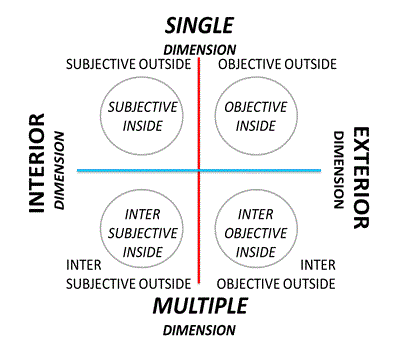
Also the insides of quadrants may be complementary opposites in a diagonal way like the “Inca Quadrants” and they may be connected with the Subtle Realm's “both-and” logic.
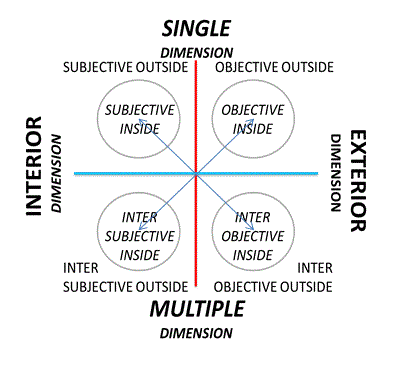
The “insides” of each quadrant belong to a non-local (but perhaps regulated/specified/limited) connection between classic, either-or quadrants and completely non-local Subtle Realm with no need for the parameters of space and time (or space-time) to define the behavior of objects in relation to interior (individual or shared) experiences. In the Left Hand, Interior side they are individual and collective phenomenological experiences. In the Right Hand side they are the self-generating, creative, non-local “poiesis” (a word related with “poetry” and implying greater free will or less dependence on the causality of exterior objects) of singular and collective objects and through quantum mechanics we understand that there's a statistical order maintained that interacts with the classical macro structures; not an absolute, “anything goes” degree of freedom. Thus the non-locality (partially but not completely escaping the strictures of space-time) is under some regulation or 'control'.
The 'inside' of the individual subjective quadrant gives us personal phenomenology which is affected by the objective, material vehicle we are using. Its correlated 'inside' in individual brain functioning would manifest as the controlled holistic and non-local quantum phenomena being discovered in cognitive science. The 'inside' of plural or collective subjectivity could be represented by hermeneutics and how subjects feel in a group and implicitly understand each other's shared rules. The 'inside' of plural or collective objectivity could be represented by self-organizing systems phenomena like social autopoiesis. In other world, the 'insides' of quadratic expressions or 'perspectives' pertaining to the Physical Realm would be like interphases with the Subtle realm but also non-local inasmuch as they conform to classic space-time arrangements. Thus, we may speak of an initial degree of non-locality. Higher degrees may operate in the Subtle and Causal realms.
Furthermore, perhaps the Physical Realm “insides” also correspond with the quadratic “outsides” of the Subtle Realm and the quadratic “insides” of the Subtle Realm correspond with the “outsides of the Causal Realm. Finally, the “insides” of the Causal Realm (connected to Absolute no-form) would correspond with all forms in all realms, reminding as of the Heart Sutra's saying which can be summarized as “emptiness is nothing but form and form is nothing but emptiness.”
The Three Selves
In Integral Psychology we use the concept of “three selves.” I relate them to how each realm imposes forms of experience to a consciousness attached to its particular forms of duality. The “Proximal Self” would be the main actualizing self; the self that actualizes the present experience of “Kay Pacha” which could be physical, subtle or causal, depending on where we are primarily functioning on. This “self” (or rather sense of self) would experience in relation to the instincts about reality provided by its most outer vehicle. When incarnated in a physical body the primary sense of reality would be physical (in a classical way) and the quadratic perspectives manifested would primarily be classical, with distinct but correlated quadrants.
The “Distal Self” would provide a link between subjectivity and objects and a sensibility to affect consciousness in relation to the latter. When incarnated in the Physical Realm it usually manifests as “I am rich, poor, a doctor a man a woman” or any other objective (but incomplete) category. It also connects a soul in the physical body with sensibility to objects or a projection of its own consciousness into objects through Subtle Realm connective, experiential energies. Thus, (albeit with less actualizing influence) it also become part of the 'present' experience of an incarnating or physically embedded person. The “Anterior Self” is attached to being distinct and to being available to any possible experience according to organizing principles emanating from Consciousness within primordial duality. It is the self that says “I am” and witnesses what happens. It still pays a (largely unconscious) role in actualizing present experience of a particular “Kay Pacha” but mostly through essential pre-conceptual, universal principle-based expectations.
Unbeknownst to a normal incarnating consciousness the main creative or actualizing force is with the Causal Realm-located “Anterior Self” about which the person is normally unconscious off. The second most powerful creative or actualizing force is with the Subtle Realm-located “Distal Self” about which the normal person remains subconscious about. It is a force of subconscious attachments to and identification with objects. The third and less powerful actualizing force is with the “Proximal Self” about which normal persons are more conscious about and which, nonetheless, specifies a world with a great plurality of exterior objective details.
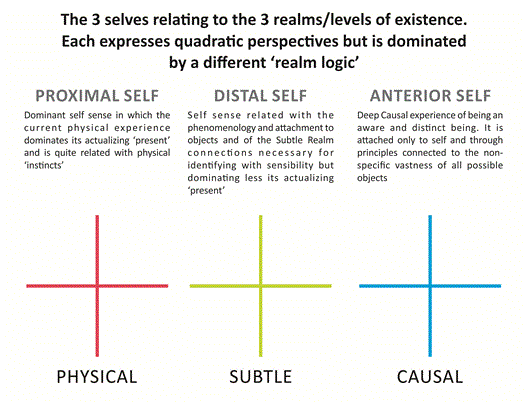
In relation to “Uku,” “Kay” and “Hanan” pachas (the three main Inca Quechua “worlds”), and in terms of experience, the “Proximal Self” would primarily be in “Kay” as the present, actualizing experience. The “Distal Self” would primarily be in “Uku” as the emerging or continuously materializing Subtle Realm providing energy and future potentials, as a plant developing roots before emerging to the visible surface. In fact, “Uku Pacha” is not only though as the world to come but normally depicted as underground both in a geographical and in a subtle spiritual way). The “seed” of that plant about to surface would come from “above,” from the “Hanan” and past form-generating Causal principles associated with the Distal Self. The importance of three realms connected to three main bodies, logics, states of consciousness, and other important Trinitarian expressions cannot be under estimated. In Inca Quechua thinking an intermediate third would be required to connect in a “proportional tension” (Tinkuy) two complementary worlds (like the multi-probable and chaotic “Uku” in the future and the orderly and abstract “Hanan” in the past) and this third element would manifest a “Kay Pacha.” Thus, actual worlds combine as potential times (reminding us of the causal and retrocausal) in an actual, experiential present.
While at their own level all these “worlds” would be “actual” they would hold relations of actuality and potentiality as to each other. This implies that actualization or adding more “grooves” or evolving patterns when primarily experiencing through a realm would be like an exchange and a flow between these realms or “pachas.”
In terms of the Platonic value spheres of the True, Good and Beautiful, the Causal and-or “Hanan” would be expressions of the “True” inasmuch as it represents the seed intelligible principles. The Subtle and-or “Uku” would be an expression of the “Good” inasmuch as it is an expression of relational balance. The Physical and or “Kay” would be an expression of the “Beautiful” inasmuch as (during incarnation) it is an expression of a non-transferable, felt sense of what is real and matters most.
The individual's “Proximal Self” would relate more with his or her subjective quadrant. The individual's “Distal Self” would relate more with his or her intersubjective or cultural quadrant and the individual's “Anterior Self” would relate more with his or her two objective quadrants.
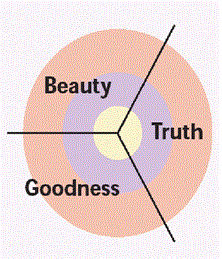
The diagram above depicts the three main Platonic “value spheres” corresponding to the quadratic experiences and perspectives. “Beauty” (ot “the Beautiful) corresponds to indefinable, qualitative, individual, Subjective experience; Goodness (or “the Good”) to the intersubjective, cultural quadrants of shared values, rules, agreements. “Truth” (or “the True”) corresponds to the individual objective and plural objective (systemic) quadrants.
All four quadratic perspectives and-or ways to experience an individual has would take part on how a potential experience is actualized by consciousness immersed in a duality-based, quadrant-producing experience. As Ken Wilber and Steve McIntosh shows these quadrants also coincide with or express the three Platonic “value spheres.” The main factor which (combined with other individuals) actualizes his 'present world' or “Kay” Pacha would be his or her non-transferable, intimate, 1st person experience (the 'Beautiful' in Platonic terms). It will be his or her Subjective quadrant. Then, the relational or subjectively shared (actually intersubjective) values and implicit cultural rules of his or her 2nd person experience (the 'Good' in Platonic terms) would also serve to actualize (albeit less intensely) an individual's present world or “Kay” Pacha. Finally, the more distant and less active in actualizing his or her present world or “Kay” Pacha would be the individual's remaining two 3rd person, (singular objective and plural objective) quadratic experiences and perspectives (the 'True' in Platonic terms).
All quadratic aspects would intervene but the ones closer to phenomenological subjective experience would have more influence than the ones which can be considered more distant of 'conceptual'. Thus, the sense of self as the 'proximal' self (which I think is also influenced by the most intimate primary 'instincts' given by a Physical, Subtle or Causal vehicle into which a consciousness is projected) would be the most powerful (conscious, subconscious and unconscious) actualizer.
The insides of each quadrant would intervene directly in the actualizing of experiences and events through their connection with the Subtle Realm. Unlike the experience in the Subtle Realm the classical physical experience would take time and space and there might be a point of divergence and transition in the inside quadratic regions in which instantaneity and no distance become hidden-to-awareness (and in that sense 'potential') retrocausal quantum level influences and available-to-awareness (and in that sense 'actual') classical causal influences.
On Ghostly Interactions
Perhaps a relatively more unified form of experience given by a freer level of consciousness operating under less dual restrictions becomes limited and divided as the experience of instantaneity and equal relational balance between interiors and exteriors (and individuality and plurality) is restricted. The degree of separation or reunification between causal and retrocausal and how much of it remains connected would be the link between the Physical and Subtle realms.
If we knew how to increase the cancelation between causal and retrocausal influences either through individual and group conscious experiences or through artificial means we might be able to increase the connections with the Subtle Realm. Perhaps when - during research conducted at “haunted” places – the room temperature and people's temperatures anomalously drops (and it is often suggested that ghostly entities are extracting energy from the physical world in order to manifest) there's also an increase in the convergence and mutual cancelation of the causal and retrocausal while the physical patterns are transferred into the Subtle Realm closest to physicality. Then by will (as normally operating in the Subtle Realm) the ghostly entity releases the pattern and either moves an object, becomes opaque to light, produces a sound, or is able to record a sound in an electronic recorder and the temperature returns to normal. The order and movement of physical molecules which has acquired a different entropy returns to its original entropic state. If the entity doesn't produce a particular physical effect he or she may simply restores the previous physical balance or state of order-disorder by emitting heat and instead of producing a cold area produces a “hot spot.”
If we could perhaps artificially cause physical kinetic energy and patterns to diminish through clashing electric and radio frequency fields (like John Hutchinson seems to have demonstrated) we might induce “portals” into the Subtle Realm while increasing the cancelation between causal and retrocausal influences. Some of the physical effects (as apparently demonstrated by Hutchinson) include a reduction of inertia and a disconnection from Earth's gravitational field. Another clue may perhaps be given by Kozyrev's experiments (described by physicist Claude Swanson) on “torsion physics” in which causal and retrocausal influences allegedly relate in a non-local connection capable of modifying inertia (similar to what physicist Ernst Mach described) can gives us some clues.
Then again, the deep cooling (even felt within the body) of an environment often experienced (and detected with instruments) by “ghost hunters” before or during “paranormal” events reminds me of the “Peltier Effect” known in electronics: when electron flow through two different wires completing a circuit produces a cooling effect at the juncture, some of the kinetic energy temporarily becomes potential and again returns to its original state. Also, if the current flow is reversed heating takes place. During “paranormal” cooling we could say that the patterns of physical energy present in a higher kinetic state are transferred to the Subtle Realm through the conversion provided by the retrocausal activity in the quantum world. This conversion activity may be what some theosophical esotericists have called the “etheric.” No physical energy is lost; it just goes into a more potential (and less presently useful) physical state. However, in the Subtle Realm, the physical patterns (whose kinetic expressions became 'potential') were transferred into a space and time free Subtle exterior manifestation environment (that is into a different kind of 'space', an Interiors-Exteriors 'relational space' or a subjectivity-objectivity 'relational space') become more immediately useful. The kinetic usefulness was transferred into the Subtle Realm whose exteriors instantly respond to interiority or subjectivity.
When an entity mainly located in the Subtle Realm consciously or subconsciously wishes to produce a physical effect he or she makes use of the physical patterns transferred into a Subtle form; his or her environment instantly responds and the patterns return to the Physical Realm reestablishing (restoring) the kinetic motion 'anomalously' sequestered. This can be done, for instance, either by moving something, producing a sound, becoming opaque to light, increasing the local intensity of electric fields. If the entity doesn't produce any of these or similar effects purposefully or subconsciously, he or she might naturally release the transferred kinetic patterns by emitting heat and creating one of the “hot spots” that have also been detected by “ghost hunters.”
In these search for patterns in which philosophy, physics and a pre-modern cosmology present clues we need to be boldly speculative within reasonable bounds. We don't need to have all the empirical the evidence to dare (although more empirical verification would be excellent to guide our modeling). I'll venture to say that, perhaps some of the physical things we can manipulate have a complementary relation akin to characteristics suggested by the symbols inside the “Inca quadrants” and by opposing them they might cancel each other out partially returning Physical Realm quadrants to a Subtle Realm quadratic state.
Physical energy may not be produced or lost but the physical entropy and kinetic patterns of order may be temporarily transferred into space and time subsuming Subtle Realm patterns and be returned (by creating a classical physical effect or by simply releasing the anomalously transferred pattern). A measure of useful physical order is temporarily transferred into the Subtle through the retrocausal link always potentially available in quantum states. The degree of connection of ordinary, 'actual' physical substance with its 'potential' mirror-like retrocausal aspect may represent the stable intermediate “etheric” states spoken about by Rudolph Steiner and other esotericists. These states may temporarily rearrange themselves into less temporarily stable new patterns when the connection between the Subtle and Physical increase and, when this occurs, the insides of quadrants may become more influential.
Conclusion
There are many indications that patterns in different fields of knowledge describing some form of complementary duality relate with the issue of inter-realm or “interdimensional” contacts.
